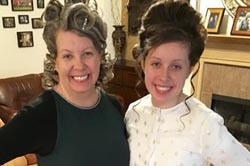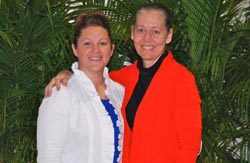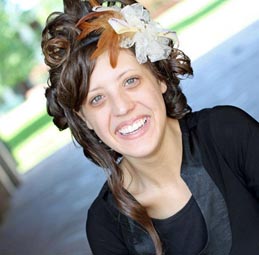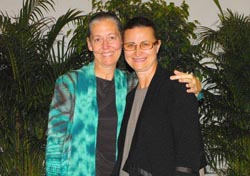Hair Culture among Generational Apostolic Pentecostal Women
By Von de Leigh Hatcher
In the southern region of the United States commonly known as the "Bible Belt," where Christianity flourishes in the form of many creeds and denominations, Apostolic Pentecostal women are often distinguished from their fellow Christian sisters as being those who wear skirts and have long, uncut hair. For the purposes of this article, I use the term "Apostolic Pentecostal" to refer to believers within the Pentecostal movement who adhere to the teachings of the apostles concerning water baptism by immersion, Spirit baptism with the sign of speaking in tongues, the oneness of God, and the life of holiness, the latter of which pertains to my subject. My article is concerned with the obedience to the biblical teaching of a woman's hair as a spiritual covering and gender distinguisher as well as how that teaching has led to the modern hair culture among generational Apostolic Pentecostal women, specifically those living in Louisiana.
I am a fifth-generational Apostolic Pentecostal woman. That is to say, my family has participated in the Pentecostal movement for five generations since the beginning of the modern Pentecostal movement on January 1, 1900 (Powers 2001, 12). For some, this is a source of pride: generational involvement indicates stability in the church, faithfulness to God, and overall familiarity with the scriptures. However, generational involvement can also lead to unique, cultural traditions within a group of people that is unrelated to scripture. A wonderful example of this generational conundrum can be seen in the hair culture among generational Apostolic Pentecostals.
I first met with my pastor's wife, Sandi Davis and her adult daughter Mandi Hartzell to discuss hair culture. I then later met with my close friend Medley Zeigler, 21, her youngest sister, Abby-Grace Zeigler, 14, and their mother, Derethia Zeigler, whose husband pastors another church. All women, like myself, have been raised in the Apostolic Pentecostal movement, and all of them have long, uncut hair, as do I.
To begin my interview, I asked, "What is the importance of a woman's hair in your faith?" Since all parties knew that I share their belief system, the responses I received varied in that some were articulate and others made vague references to scriptures and ideologies with which they knew me to be already familiar. Derethia Zeigler responded first by reading aloud 1 Corinthians 11: 15: "But if a woman have long hair, it is a glory to her: for her hair is given her for a covering."
"Long hair–to us–represents glory. It's our protection. It also shows that we are in submission to our husbands, and it is for the glory of God," Zeigler said. In the same vein, Sandi Davis replied:
Well, the Bible says that it's a covering. And that's the importance, . . . I believe it's the covering. . . . Some people doubt the covering of the angels, you know, some people go that route, but I don't. But for me, it's always been: I accept that. I believe that. That's what I was taught. And that's what I've embraced. And that's what we have taught. But anything I can do to protect my family and my home, I'm going to take that even to maybe the extreme. Some people may call it extreme.
The scripture referenced here is taken from 1 Corinthians 11, one of, perhaps, the most contested chapters in the Bible among Christians today. The overall theme of 1 Corinthians 11 is spiritual authority and submission to spiritual authority, and it is filled with much metaphorical language. Jesus Christ is described as being the "head" of the Church and of men as men are the "head" of their wives (1 Cor. 11: 3).
(My own parents like to joke that the woman is the "neck" which turns the "head"!) Verses 4, 7, and 14 say that it is a shame for a man to pray or prophesy with his head covered or to have long hair. Verses 5, 6, and 17 say that it is a shame for a woman to have shorn or shaven hair and that her hair is given to her for a covering and a sign to the angels. However, Paul also writes, "Nevertheless neither is the man without the woman, neither the woman without the man, in the Lord. For as the woman is of the man, even so is the man also by the woman; but all things of God" (1 Cor. 11: 11, 12).
As Janet Everts Powers stipulates in her article, "Recovering a Woman's Head with Prophetic Authority: A Pentecostal Interpretation of 1 Corinthians 11.3-16" (2001), this chapter is interpreted by many Pentecostals to be less a statement of gender inequality and more a statement of gender distinction. "Those who champion this view believe that the text is not about veils and artificial head coverings but about sexual identity issues connected with symbolism of long hair or short" (Massey 2011, 53). Some scholars do believe that the chapter is referencing physical veils and hats when it mentions head coverings, others think it is referencing hair. I have seen Pentecostal women who both wear veils and have long, uncut hair, but this is most often seen among particular ethnic groups and not among Apostolic Pentecostals as a whole. Nevertheless, my focus is not on the biblical definition of long and short, veiled and unveiled, female and male. I am primarily interested in how women, who interpret 1 Corinthians 11 to mean that they should not cut their hair, learn to maintain their hair and to perceive beauty in hair.
In both interviews, the mother took the responsibility of establishing the family's belief and interpretation of scripture concerning hair. Of course, if I had been the one being interviewed and my mother had been present, I might have done the same. For generational Apostolic Pentecostal women, the ultimate authority on hair is generally the mother. This stems, in my opinion, from the natural flow of mother/daughter teaching. Apostolic Pentecostal women teach their daughters about hair just like most mothers all over the world teach their daughters the norms and taboos about hygiene, reproduction, and physical appearance.
That is not to say that Apostolic Pentecostal fathers have no involvement with their daughters' understanding of gender distinction and biblical beliefs about hair. My own father sat with tears in his eyes and a Bible open in his lap after I, at the age of 9, had cut my hair, and explained why he did not want me to cut my hair. This is a moment that is etched in my memory, and I have never cut my hair since. However, my father never knew how to do more to my hair than brush it. To learn how to wash, brush, and dress my hair, I looked to my mother, my sister, and the Apostolic Pentecostal world around me, as did the women I interviewed.
Hair care, of course, largely depends on an individual's hair texture and condition. An Apostolic Pentecostal woman of African descent will learn to do her hair differently from a white, Hispanic, or Asian Apostolic Pentecostal woman. Curly hair and straight hair have to be treated differently in regards to washing and brushing. For example, Davis and Hartzell both have straight hair while the Zeigler women all have curly hair. Women with straight hair typically brush or comb their hair more than women with curly hair. However, all women agreed unanimously that they were taught to brush or comb their hair by beginning at the ends and working their way to the roots, regardless of their hair texture.
Mandi Hartzell remembered a time when she was a girl and her mother was away from home: "I can remember being a child and not you (mother), but I think dad had been in charge of me at one point, and he was supposed to be helping and was clueless. And I don't remember her name but . . . I just remember her telling me 'No, no, no! You start at the bottom!'"
"She was the babysitter," Davis interjected.
"And she was helping my dad for the moment. He had dropped me off and said, 'I don't know what to do with her hair!' And she was like, 'Oh! Let me tell you what to do,'" Hartzell said.
Hence, in the Apostolic Pentecostal movement, women learn from women how to care for their hair. One time, I remember traveling with a group of ladies to a conference, and as we were getting dressed, one lady, who was a convert, cried out as she tried to brush her hair from the roots to the ends. Quickly, my mother and other ladies intervened by teaching her how to painlessly brush her hair by working the brush in a downward motion by segments from the ends and continuing up to the roots.
For practical purposes, most Apostolic Pentecostal women do not wash their hair every day. Like Mandi Hartzell, my hair length extends to my knees. Washing that much hair can be cumbersome for multiple reasons. For example, time has to be factored in for the hair to dry. My own hair takes approximately 2-3 hours to totally dry naturally. Also, freshly washed hair can be more difficult to style. To construct the sometimes elaborate hair styles for which Apostolic Pentecostal women are renowned, the hair needs be either slightly oiled, fixed with hairspray, teased, and/or all of the above, depending on the hairstyle.
Hair styling itself is the cause of some controversy among Apostolic Pentecostals. Dr. David K. Bernard, the general superintendent of the United Pentecostal Church International, Inc. and president of the Urshan Graduate School of Theology in Hazelwood, Missouri, writes along with Loretta A. Bernard in their book In Search of Holiness:
There are two concerns regarding a woman's attitude toward long hair. Some may resent the need to care for and fix long hair. But with moderate effort it is possible to fix long hair so that it looks modern, neat, and attractive. . . . It is possible to take the very hair that is supposed to be sign of submission and arrange it in ostentatious display. Overly elaborate hairdos and extravagant hairpieces draw attention to self rather than the message of long hair. . . . Many people have been impressed with the beautiful, holy, long hair of Christian women, but others have been perplexed, confused, and repelled by showy displays (2010, 136-137).
Keeping this in mind, I asked my interviewees the following questions: "Do you think it is possible to be too simple or too extravagant in a hair style? If so, where do you draw the line? What is not permissible, in your opinion? What is tolerable? What is beautiful?" To these questions, answers varied tremendously, except for one. Each woman agreed that the most unattractive look for an Apostolic Pentecostal woman was no hairdo at all. "Stringy, maybe combed but nothing in it–nothing to dress it up! To me, that would be just as much a distraction as some other far-out hairdo, you know, real big," Derethia Zeigler said, indicating with her hands the parameters of a hairdo that she considered too big by placing her hands nearly a foot above her head.
"She means if it looks just unkempt, uncared for," Medley Zeigler added, "Just down and stringy and all over the place, and people can just look at you without asking and know 'Oh, she really just didn't fix her hair today'."
"Some people ask why we don't always wear our hair down," Davis noted, saying that she had begun wearing her hair in a bun all of the time after she had children. For her, it was more convenient to wear her hair up and keep it out of the grasp of little hands. Derethia Zeigler believes that by wearing one's hair down, without any accessory to hold it back somewhat (such as a headband, beret, clip, or pin), can be a hindrance to the lively worship in Pentecostal church services, which often constitutes handclapping and the raising of hands. An underlying fear among Apostolic Pentecostal women, however, is that they should appear to be wild, "unkempt," unruly, or associated in general with unpleasant imagery.
For example, when I was still very little–no more than 5 years of age–my mother would put my hair in a bun for church. As soon as the service was ended, I would hasten to loosen my hair. In this natural state, I would be affectionately reprimanded for looking "like a witch." Of course, witchcraft is the very antithesis of Christian dogma (Galatians 5:19-21). So, if long, "unkempt" hair is associated with being witch-like, then, Apostolic Pentecostal women feel that they must put some effort into resembling the glorious women of which the angels take note in 1 Corinthians 11.
"I think that it's a very big deal that they learn to fix their own hair, and to when I say they fix, I mean that they do very unique things with it at different times. I mean, they usually have three or four hairstyles that they can tuck under their belt that they can pull out any time that they need to, depending on the occasion," Hartzell said.
The Zeigler ladies agreed to every Apostolic Pentecostal woman having "at least" 3 to 4 hairstyles ready at hand, although hairstyling is something difficult to number, as it often consists of various combinations. Every woman also agreed that hairstyles generally differ depending on the occasion. For example, while I was interviewing the Zeigler family in the comfort of their own home, Abby-Grace Zeigler wore her hair in a simple bun while Medley Zeigler had thrown her hair casually into a pony-tail. However, in a church setting, they both wear more elaborate hairstyles, featuring accessories like flowers and beaded headbands.
In my own personal observations, I have noticed that the greater variety in hairstyling is usually seen in younger, unmarried women, whereas, married women or women with children, tend to wear more sober or simple hairdos, though there are always exceptions! These variations, like Sandi Davis hinted, are correlated to practicality. A young, childless woman typically has more time to dedicate to her appearance, especially on a Sunday morning, for example, if she does not have children to dress and feed. On the other hand, a woman who is married and/or has children might have less time to care for her appearance when confronted with more pressing matters like feeding her children. One can also imagine that many young, single women feel more pressed to appear attractive to the opposite sex in a society that places much emphasis on the importance of marrying within the faith-based community and therefore, take more care with their hairstyles.
In fact, Sandi Davis, who personally prefers simple, "classic" hairdos like the chignon or French twist added that she thought that some women "need" to wear their hair more elaborately in order to feel feminine and beautiful. Again, we see the repetition of the idea that the woman's long hair is a glory, and, thus, the thin line between appropriate and elaborate. The appropriate-ness of a hairdo is often defined as being dependent on the culture of the area as well as the culture of the era.
Contrasting the hairstyles frequently seen among Apostolic Pentecostal women in Louisiana versus those seen in other states, Mandi Hartzell stated, "Well, I think, one of the funny, quirky things to me is that some of the, um, even if it's the non-Pentecostals, Texas is known for big hair. But even within the Pentecostal movement, I think it holds very true that they still stay kind of within our culture but then they still have big hair! Again, within my experience!"
Both Sandi Davis and Derethia Zeigler could remember a time when Apostolic Pentecostal women from California to Mississippi and everywhere in between would pile their hair into the "Sister Patti Pentecost" beehive bun, which often involved elaborate, extreme measures of time and layering of hair and accessories to produce. Women would take oatmeal boxes, Davis and Zeigler remembered–recounting stories that very much resembled the stories I had heard from my mother while growing up, and sculpt their hair over the boxes carefully in order to achieve a look that resembled some of the depictions of Marie Antoinette. However, during the 1960s and early 1970s, large hairdos called "beehives" and "Afros" were popular even in the modern American pop culture. Although to my eyes, the old Pentecostal hairstyles were ostentatious and distracting, some concede that it was a reflection of the culture at the time and therefore, not too flamboyant. Both Davis and Zeigler noted that by the 1980s, Apostolic Pentecostal women began teasing their hair much like their non-Pentecostal counterparts. In the 1990s, they remembered the central front "pouf" that led to a more tamed bun, which led to the curly popular bun in the early 2000s.
By this point, Medley Zeigler and I were able to contribute our own knowledge of the hair culture in our movement. I remember my sister curling her hair before service and letting several tresses fall about her face while piling the rest up into a high bun. Currently, Mandi Hartzell and Medley Zeigler have noticed that women are starting to wear a more "natural," "simple" style that typically uses braiding techniques.
"On big, fancy occasions, you know, I've seen them pull out the, you know, two-stack high hair and perfectly coiffed curls. . . , but on the flipside of that, especially in a more casual setting, I think there is a movement toward a very natural hair. Like, I see so many of our girls–you know, many years ago, I don't know if you saw it often–wearing their hair down. And they may have taken the time to straighten it or to do something to it. They are trying to achieve a natural look with it. Kind of just letting you see the hair without all of the just extra stuff. Right now it's really, you know, just doing a single braid, or something like that," Hartzell said.
It was noted that the Disney film Frozen has inspired many women to experiment with waterfall braids and to incorporate braids more into their hairstyling. Again, we see how the modern popular culture influences the hairstyling techniques of even generational Apostolic Pentecostal women like the Zeiglers and myself.
Sandi Davis noted that in Louisiana, in particular, Apostolic Pentecostal women have become simpler in their styling, which she attributes to the sleek bun worn by Mickey Mangun, who is quite the celebrity in the Pentecostal movement. Mangun, whose husband pastors the Pentecostals of Alexandria, is known for her gift of song. She has sung at inaugural ceremonies for President Clinton, Governor Jindal, and, most recently, for Governor John Bel Edwards.
Each of the ladies I interviewed agreed to having, at one time or another, been to a "hair-do party." This is an event where ladies from a particular church will meet together for the purpose of learning new hair styles. Sandi Davis said that although she has been to them before, she does not particularly like them. Whereas, Derethia Zeigler feels that it is a wonderful event that draws women close together and allows them to have fun while simultaneously learning new hairstyles. This is deemed as being mostly designed for the benefit of new converts, however, as it is understood that generational Apostolic Pentecostal women grow up in the hair culture and learn from their mothers and female relatives from an early age. I would argue that hair-do parties still contribute to the collective knowledge of hair-styling among Apostolic Pentecost-al women more than they give it credit. None of us are born with the knowledge of how to style our hair. It is something learned through interaction with other women, be it mothers, baby-sitters, sisters, or best friends.
Before social media websites like Pinterest existed, girls like my sister would copy hairstyles seen in magazines and keep the clippings in a photo album. Now, Medley and Abby-Grace Zeigler admit to looking at websites like YouTube and Pinterest for hairstyling tutorials. Indeed, typing "Apostolic Pentecostal hairstyles" into the search engine toolbar on YouTube's website brings 6,080 results in 2017, nearly 2,000 more results than when I began this research in 2015. Thanks to social media, learning hair styling techniques has become even more accessible not only to Apostolic Pentecostal women, but even to non-believers who wish to emulate "the Pentecostal bun."
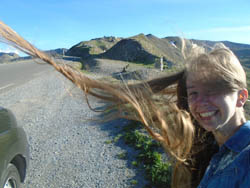
Thus, we can see that the hair culture among generational Apostolic Pentecostal women involves more than an interpretation of 1 Corinthians 11; it is a lifestyle in and of itself that involves community effort on behalf of the women participating in the belief system, creativity, and cultural sensitivity. What I have learned through my research is that generational Apostolic Pentecostal women have a relationship with their hair that encompasses love for its symbolism, pride in its glory, patience in its construction, and--every once in a while--frustration in its upkeep. Overall, our hair is something that we spend our lives thinking about--almost unconsciously. We do not even realize how much we think about our hair. Our hair is a part of us. Behind the hairstyle, whether classically simple or elaborate, there is the strong belief that our hair is given to us as a symbol of glory and of divine protection.
Notes
All interviews were conducted by the author in April of 2015 and were personally recorded and transcribed. The subjects interviewed are of no family relation to the author. Sandi Davis' husband is the pastor of The First Pentecostal Church of Baton Rouge. Derethia Zeigler's husband is the pastor of The Pentecostals of Ascension. Both churches are affiliated with the United Pentecostal Church International.
Biblical quotes and references not originating from an identified source are taken from Rhe Thompson Chain-Reference Bible, K.J.V., 5th ed. edited by B. B. Kirkdale.
Sources
Bernard, David K. and Loretta A. Bernard. 2010. "Bible Truths Concerning Hair." In Search of Holiness: 25th Anniversary Edition Revised and Updated. Hazelwood, MO: Word Aflame Press.
Kirkdale, B. B., ed. 2008. The Thompson Chain-Reference Bible, K.J.V., 5th ed. Indianapolis: Bible Company.
Massey, Preston T. 2011. "Long Hair as a Glory and as a Covering Removing an Ambiguity from 1 Cor 11:15." Novum Testamentum 53, vol. 1: 52-72.
Powers, Janet Everts. 2001. "Recovering a Woman's Head with Prophetic Authority: A Pentecostal Interpretation of 1 Corinthians 11.3-16." Journal of Pentecostal Theology 10, vol. 1: 11.


